



It was not the cyberpunk universe you were looking for.
Our nostalgia centres were lit up with a cut from a flying car to a full screen eyeball staring across the opening scene, synchronized on the script and musical score of its 20th century precursors’ timing. From there, audiences of the Blade Runner sequel were dropped into a pale California wasteland blanketed with conglomerate agricultural biofarms, an antithesis to cyberpunk’s damp, urban hybridity. The green, utopic space beyond the city– only glimpsed at the end of the 1982 original theatrical release and removed entirely in the director’s cut– was where we started from in Blade Runner 2049, and (surprise) there’s nothing but the dystopia of the anthropocene to look forward to there either.
Times change.
The recently post-industrial, 20th century cyberpunk rebellion of bodily sensuality: the noir lighting, the baroque candelabras burning, the lingering fingers stroking out haunting piano music; these were relics now, hinted at, ghosts of a genre in its past moment. Even the endless rain characteristic of the cyberpunk genre was repeatedly replaced with snow in Blade Runner 2049. A borrowed soundtrack teasing the familiar bridge to a heroic death scene came without poetic dialogue or even a witness. Rogue replicants were not criminals, but escaping criminality. Even memories were no longer stolen in this world, but legally manufactured, a convention stripping the typical cybernetic plot of bioharvesting found in cyberpunk down to a more contemporary, bioengineered ethics of classed and raced co-humanity if ever there was one. No, this ethical failure was smoother, blended into liberal values and legal structures, more sanctioned somehow.
The 80s cyberlibertarian world of the white lone wolf, struggling for autonomy in a hybrid, post-globalized world of orientalist economic takeover, had passed by in the great data “black out” of 2020 apparently, and Denis Villeneuve didn’t care about your need for consistent genre romance. Sort of. Rather, the director brought the audience’s need for Blade Runner nostalgia in and out of the sequel like a tool, cuing our attention to wait for it, partially rewarding us with a sensory, semi-nostalgic moment, only to glitch before nostalgic completion. Again and again, it was invitation and estrangement from our own expectations. Blade Runner 2049 was a highly self-aware remix of its own postmodern references and refusals in a predetermined world.
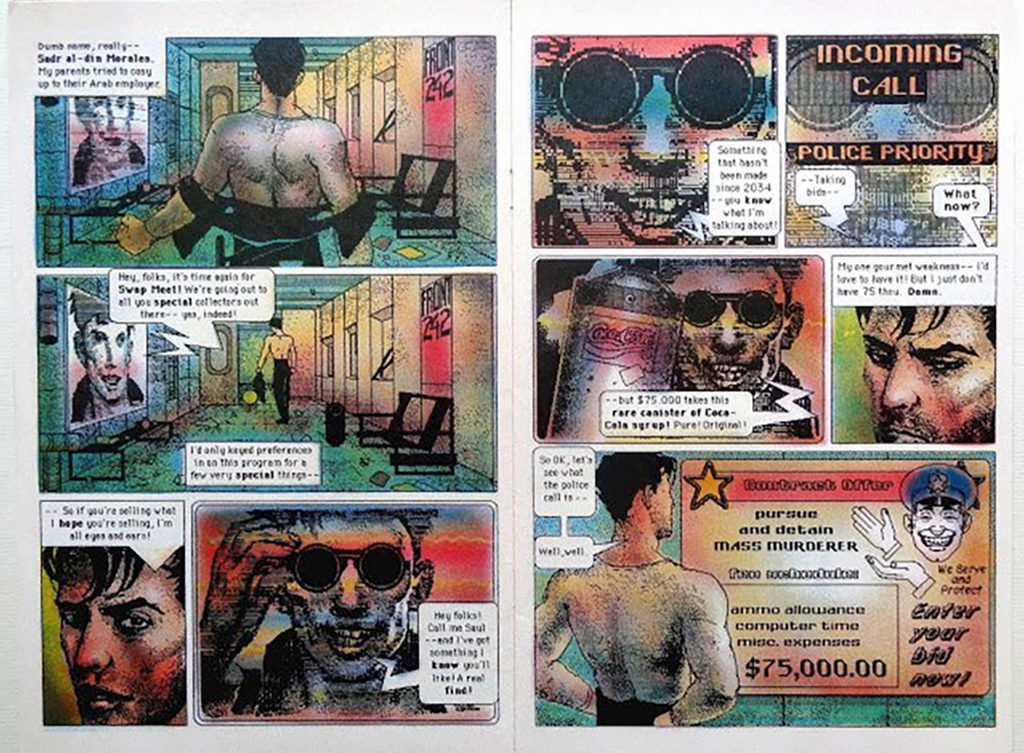
Perhaps a hybridity across two cyberpunks of historical time and cultural change was apropos. Ridley Scott’s genre critique of the corrupt corporation had evolved since its 20th century take in the Alien franchise, expanding to consciously address our own implication in the techno-dystopian social narrative. It turns out that we are no longer universally laboring blue collar victims in the secretive horrors of impending biopolitical technocracy. Rather, we are eager and satiated participants in its isolating ubiquity; high tech consumers implicated in all of the attendant social stratification, inequality, and suffering that its warm glow of access masks and accelerates, from facilitated gentrification and casualized labor, to the toxic, extra-legal wastelands of dead electronics processing.

Disruptive innovation has predominantly benefitted the 21th century, western, science fiction audience. Our classic cyberpunk desire for the vindication of the social outlier– the androgynous Sigourney Weaver in a corporate-threatened future of full equality and bodily autonomy, or the replicant who can reclaim a subjectivity beyond his or her social paradigms and slave programming– has since been turned on its anti-establishment head. Scott’s film Covenant saw this come to fruition when the Menippean Anti-hero, Bakhtin’s rebellious, paradigm-questioning literary figure cloaked in the absurd eloquence of language, is fledged into a full sociopath. We saw this in the philosophical and intellectual character of David and his calculated experiments to replace the evolutionarily inferior human species. If Menippean satire is “a genre for serious people who see serious trouble” (Howard Weinbrot), than what is this?
By Covenant, our anti-hero no longer presented the humanistic redemption narrative of the Menippean Nexus 6 leader, Roy Batty, in the original Blade Runner. Instead, Covenant gave its inverse: a regressed society being shown the mainstream values it has come to love and endorse in a world of neoliberal anti-establishment leadership. So much for the underground resistance crouching in the street garbage. The 21st century universe of cyberpunk has been one of well-mannered disruptive innovators of the species, philosophically visionary proponents of transformative wealth models built on slave bodies, and the “technê-Zen” veneered (R. John Williams) institutionalization and naturalization of technological sociopathy. Here is a social darwinist instrumentalism for our post-human age of market-driven measures of social success and impending climate change. In this universe, androids can be humanist while humans can be androids in an inhuman system, conveying either ‘progress’ by any means necessary or a losing sense of civilizational duty. Whose side, Covenant asked of us, before its devastatingly feel-bad ending, were you hoping would win anyway?
David, it turns out, was the only anti-hero we deserved now.
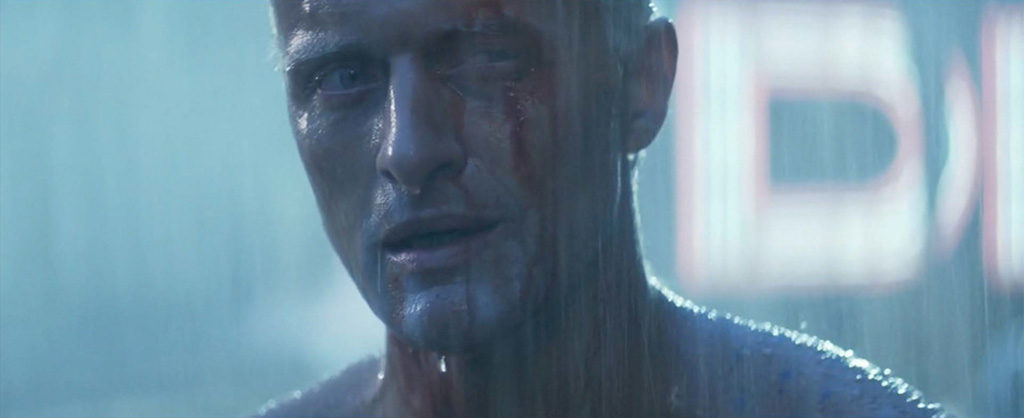
Denis Villeneuve’s sequel fits surprisingly in this updated cyberpunk universe. Like Walter in Covenant, the replicant hero who becomes Joe in Blade Runner 2049 (in contrast to Roy Batty) clearly lacks the eloquent language and especially satire of the subversive, Menippean Anti-hero character. Surprisingly, we find his strain of articulate stream-of-conscious in the tech empire guru played by Jared Leto, drained of all the feeling and trickster-like ability of Roy Batty. Joe, however (like Walter), is simple and humble in his speech, seemingly able to feel but dying suggestively in silence off screen. Robbed of the poetic dialogue expected of the death scene, only a soundtrack bite nostalgic of Roy Batty’s final scene signals a death of redemption for Joe in Blade Runner 2049. Yet the unsentimentally raw, blank slate of Joe’s expression asks of his audience: What do we see through his eyes? What language could possibly be used here to convey the gravity of a moment when power so regularly denies and manipulates the language of our experiences? In this silence, we are perhaps left to only wonder what we would be feeling.
What if it had ended differently? Would Roy Batty’s eloquent speech achieve the same humanizing disjuncture today, or does it really belong now to Niander Wallace, our tech monopoly visionary of the neoliberal age, emptied of any contradiction with the smooth flow of progress rhetoric and sociopathic public morality? Niander Wallace as foil who cannot stop talking makes Joe’s uncharacteristic silence all the more uncanny. According to Jonathan Auerbach, the uncanny involves a “trespassing or boundary crossing, where inside and outside grow confused… reveal(ing) dark secrets hidden within.” Auerbach is talking about film noir here– a highly unsettling sensory genre metabolized into the late Cold War aesthetics of the Blade Runner world. But perhaps we can relate this psychic role of the filmic uncanny to other hybridities explored through expressionist media, where the formal manipulations of sight and sound once conveyed the uneasy clashing of two worlds affectively.
Is Villeneuve’s silent denial of a hero’s dialogue in a death scene, for a Blade Runner audience, purposely estranging? Does it achieve the same, disorienting “uncanny bodies” (Robert Spadoni) that silent film audiences, unaccustomed to sound in their movies, reported with the introduction of Talkies? Film scholar Shane Denson describes how post-Talkie movies of the Thirties like Frankenstein (1931), were created in a period of transition and between the old and new ontologies of silent and sound film media. Denson argues that such films, working after the initial novelty of Talkie exposition wore off, played affectively with the new hybridity of films formalist storytelling qualities. In doing so, these films drew attention to our participation in media: “sight and sound conspire(d)…to encourage the viewer’s medium sensitivity, to coalesce with the perception of a constructed monster.” And what is a sequel, after all, if not a constructed monster of narrative to become conscious of?

“Questions.”
We live in a time of the seductive post-human technologization and normalization of very inhuman institutions, public policies, and person-like entities whose social impacts are all too often screened over with ‘alternative’ narratives of language. Glitches in this flow of mainstream mediated ways of knowing can be more than anti-nostalgic; they can be disruption to the alt-fact hyperreality in the neoliberal 21st century. Are uncanny bodies of the sensorily unexpected (or, even, dissected) what we have left to successfully slow down and stutter our neoliberal ubiquity for hearing chasm-filling speech? Can such estrangements allow us the conscious relationality to once again actually hear and see how we are hearing and seeing each other?
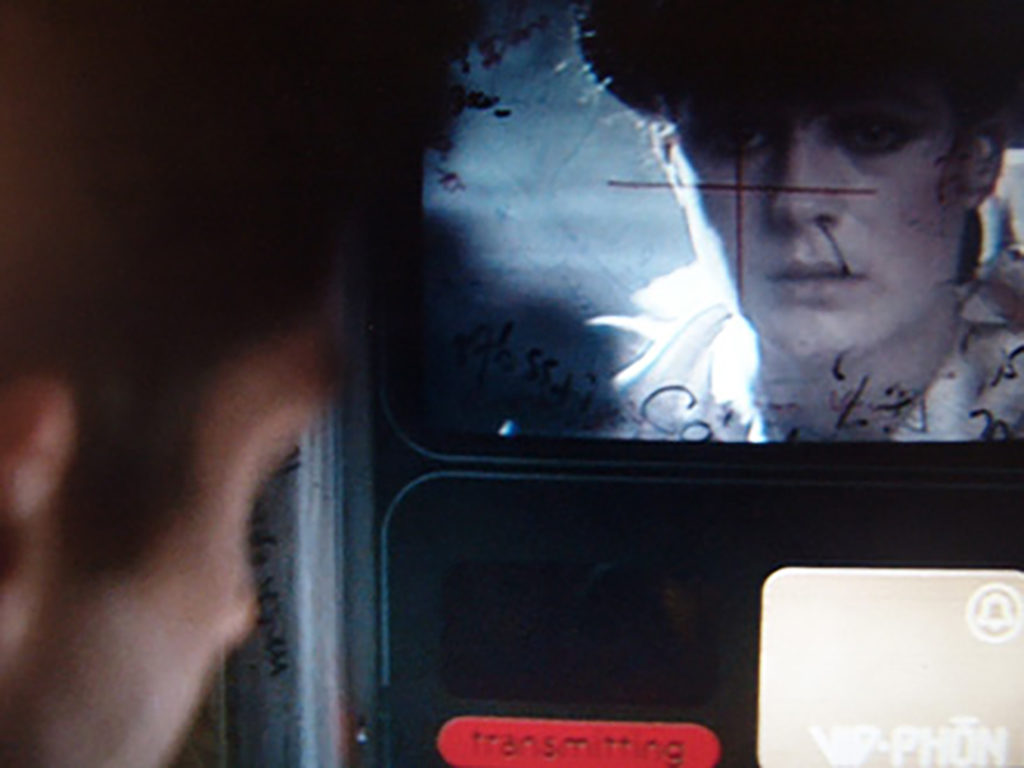
It is convenient to note here that the technological imaginary of the first Blade Runner movie refused ubiquitous surveillance. Blade Runner 2019 even refused a conception of the personal communication device so often credited with fracturing collective sociality in both sci-fi and reality. Decker, for example, calls Rachel from a public videophone in a bar. Whether human or replicant, technological worlding of the original Blade Runner insists on the communications scale of face-to-face human relationality. By the end of Blade Runner 2049 this same scale of technological imaginary in the original film returns. It is the death of one body, the replicant called “Luv”, that seems to end the limitless reach of panopticon technology that helps advance the plot.
Some kinds of love can destroy. Scene from Blade Runner 2049
This act leaves the future of Blade Runner’s Earth yet again to the relations between two, individual physical bodies. With the 1% most likely afloat in the outer world colonies, we might assume this means that it’s up to Us to cross the interface of hyberbaric differences. At a time when love has become perverted with neoliberal logic– instrumental, utilitarian, stripped of its greater sense of equality or duty– it seems that Villeneuve graciously gives us an answer here, if not a fantasy to hold on to. Perhaps one consistency in the Blade Runner franchise is the argument, like that of Junot Diaz on neocolonial oppression (as if it ever ended) and the uptick of white supremacist domestic terrorism, that it is ultimately intimacy with the Other and rejection of the glorified “lone wolf” mentality that must be revolutionary: “Vulnerability is the precondition to contact.” What if being in our present moment requires the vulnerability of silence?
“Listen:”
Nostalgia has come unstuck in time. In Ghosts of My Life, the late Mark Fisher wrote extensively of the threat of nostalgia in postmodern cultural production. Building on theorists Frederic Jameson and Bifo Berardi to explain the bending of new technologies to recycle comfortable and profitable cultural forms for capitalism, Fisher explains how “…the nostalgia mode subordinated technology to the task of refurbishing the old”, not of specific past styles, or periods, but forms of never-fully-present time asynchronicity. Consider it like another outdated, self-reproducing model, ever expanding all around you to stay relevant. Perhaps you can finally see its now, like a loose eye, engineered, removed from its familiar socket.
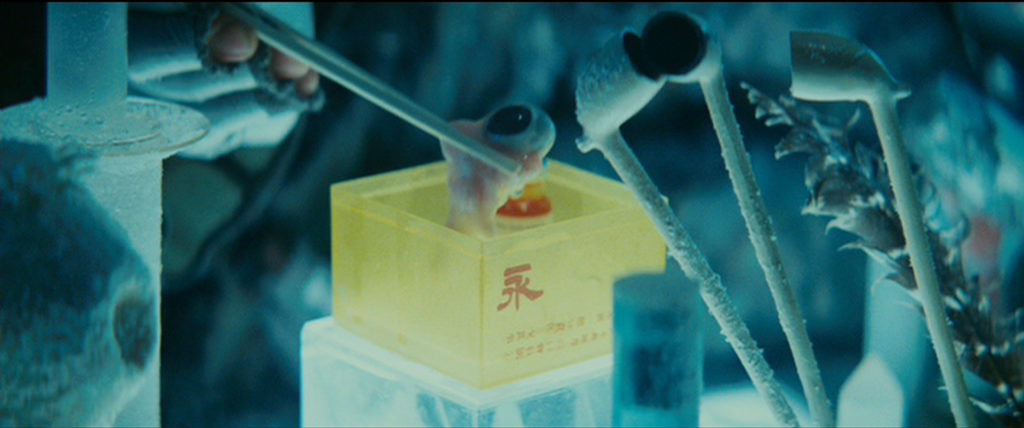
Transgressive fiction has this way of making our boundaries visible in the crossing. The reader may resist its dehumanization, suddenly queasy. Barthes once wrote about the surrealist Georges Bataille’s Story of the Eye, a modernist novel from the early mid-20th century which indeed involves a plucked eye and its “metaphorical journey” across other eye-like images. An object, he wrote, “can pass from hand to hand… or alternatively it can pass from image to image, in which case its story is that of a migration, the cycle of the avatars it passes through, far removed from its original being, down the path of a particular imagination that distorts but never drops it” (his emphasis). Barthes felt The Story of the Eye was less a novel and more like poetry. Through its avatars and crossing of sensory metaphors, the eye simultaneously “varies and endures.” Consider the following example of crossing sensory metaphors from the Blade Runner sequel: eyes, cells, tears, rain, leaking, bleeding, blinking, seizing, splashing, drowning, watching, “cells”. And what if this thing we now strangely see so differently is neither naturally born nor autonomous, but a constructed thing?
How eerie.
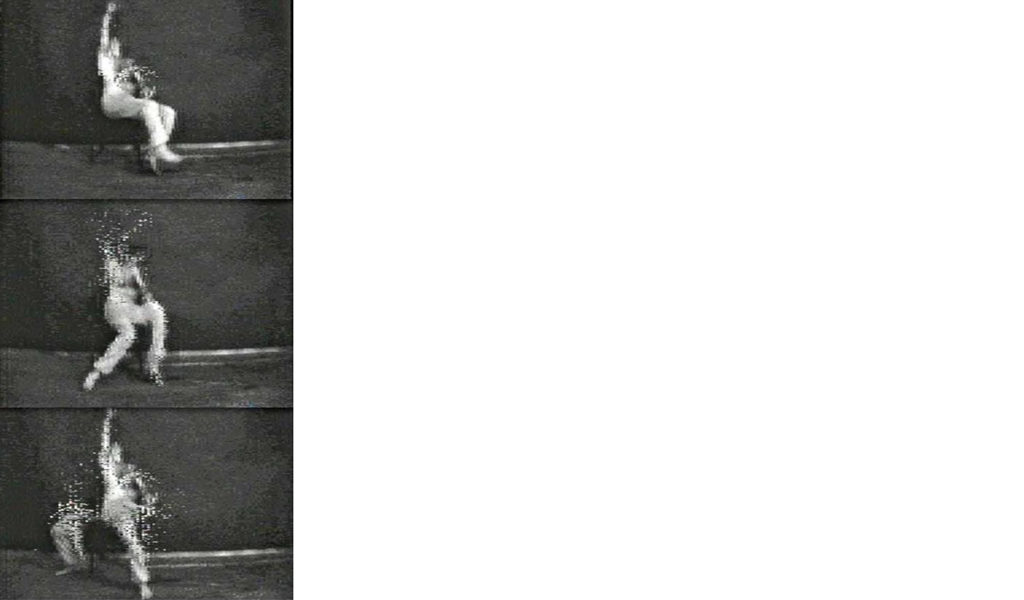
Eerie like the absence of “future shock” in the futuristic. According to Fisher, nostalgia mode production is an aspect of the “cultural logic of late capitalism” that “…disguise(s) the disappearance of the future” and prevents any real possibility of innovative “rupture”. Nostalgia in our entertainment helps stabilize the “cultural deficits” created under globalization, soothing the simultaneous “exhaustion and overstimulation” of instantaneous and transactional relations we can’t seem to deal with. It fills a high-speed chasm of emotion, truth, and meaning. It denies us the “uncanny” recognition of our temporal futurelessness, left teetering on neoliberalism’s precarity of resources “despite all its rhetoric of novelty and innovation…”
Let’s just be honest here: by the time the Coke commercial hologram showed up in Blade Runner 2049, it was a joke on our desire for even nostalgic product placements.
Nothing changes.
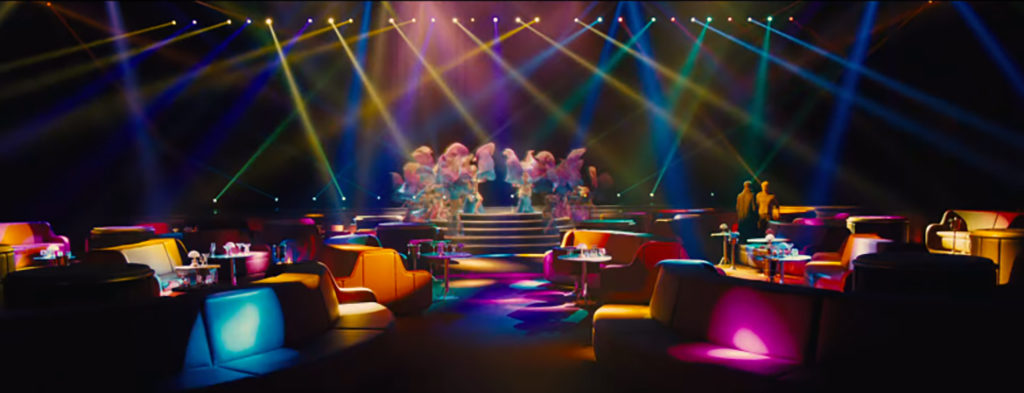
Dipping into the media art world at this borderland, theorist and filmmaker Hito Steyerl writes in “A Thing Like You and Me” about the video that David Bowie put out in 1977 for “Heroes”:
He sings about a new brand of hero, just in time for the neoliberal revolution. The hero is dead—long live the hero! Yet Bowie’s hero is no longer a subject, but an object: a thing, an image, a splendid fetish (…) the clip shows Bowie singing to himself from three simultaneous angles, with layering techniques tripling his image; not only has Bowie’s hero been cloned, he has above all become an image that can be reproduced, multiplied, and copied, a riff that travels effortlessly through commercials for almost anything, a fetish that packages Bowie’s glamorous and unfazed postgender look as product. Bowie’s hero is no longer a larger-than life human being… but a shiny package endowed with posthuman beauty: an image and nothing but an image.
What are we to do when no degree of protest or declaration can make an exploited object be seen as a subject? Where is one to find anti-heroism in all of this? Let us be objects of severe agency then. Models that are perhaps transferrable, but unobtainable. One of a kind and replaceable. Constructed yet autonomous.
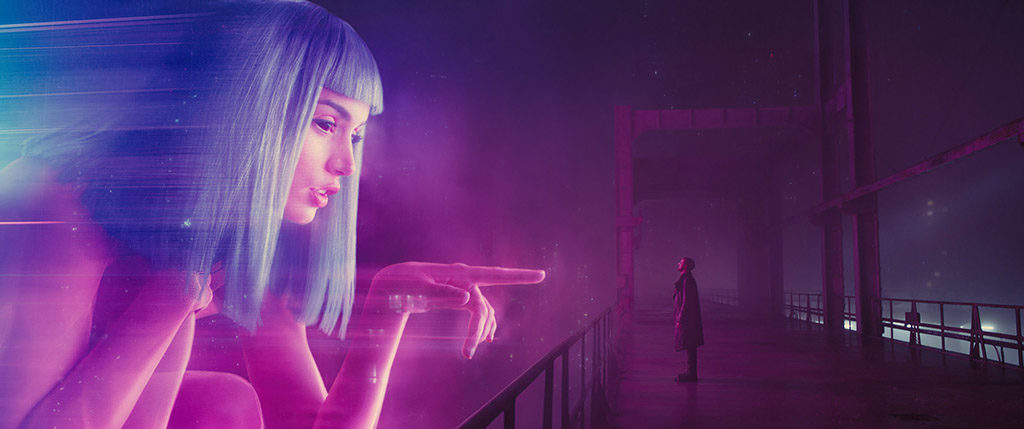
Perhaps then we can only view these things in suspension: the need and refusal of nostalgia as liberating human process, the uncanny increments of our cultural evolution to product and media-focused estrangement, the will to see one’s own familiar pixels blown wide open. “Digital information is … characterised by transformation, degradation, circulation,” explains Hito Steyerl in an interview in Rhizome, “but also by its surprising ability to mutate and produce unpredictable results. The glitch, the bruise of the image or sound testifies to its being worked with and working; being passed on and circulated, being matter in action.” Futureless. As futureless as staring into a present ruin, expansive but without destination, the destination without purpose.

Apropos, then, how our old and new heroes meet in that ruined casino scene, outcasts of white difference (by the future racialization of the synthetic) in an atemporal Las Vegas, framed by primordial Seven Wonder monuments to the our foundational schisms of misogyny (yes I’m also talking about me).
In this incarnated ruin of our stubbornness for cultural mythologies, I was struck by the brilliance of the fight scene, the director literally exploding our pixel expectations of 20th century nostalgia as soon as Harrison Ford makes his long-awaited appearance. The sonic build-up of Decker’s familiar piano in the distance was dissolved by the strange sound of his disembodied voice un-cueing an upcoming appearance in the scene, his visual reveal in that moment of our auditory let down, confusing: Desire misfiring. The ensuing cyberpunk clash-as-fight-scene of 20th century romantic and 21st century post-romantic dystopic characters corresponds to the casino’s hologram interface of an imagined, mid 21st century entertainment technology; all of the expected glamour and nostalgia is allowed to barely seduce us before sputtering and malfunctioning as filmic metascene. Within the plot, these post-apocalyptic hollywood holograms are also a sign of the future sentience to come in the character of Joe’s AI wife, Joi, and a warning that all technology rebels and mutates from initial human intentions, no matter how superficial the design intentions.
My interpretation of this violent casino stage scene in light of a more recent American mass shooting of an ever-expanding, historically singular, and self-containing statistic of “largest ever” is not lost on me. Neither is the choice of mid 20th century entertainers like Elvis and Monroe who notoriously performed like automatons with post-human qualities, their movements in time-space of perfect bodies turning on the master clockwork of a still-industrializing cultural machine before blowing apart, fragmenting. Their avatars echo of consumer-creator bodies in our postindustrial world of 2.0, gig labor, automated economic transactions feigning meritocracy, and a model of precarity demanding the inhuman perfection of individual responsibility for every movement which can shudder, glitch, and explode on other people all too frequently.
This failure is that of speculated, plotted, rationalized, and technologized courses whose error cannot be properly imagined, only realized and refused in the ruins of a short-sighted economic-cultural imaginary. Our looking back on dystopia hints at our present expectations only.
“Irreversability.”
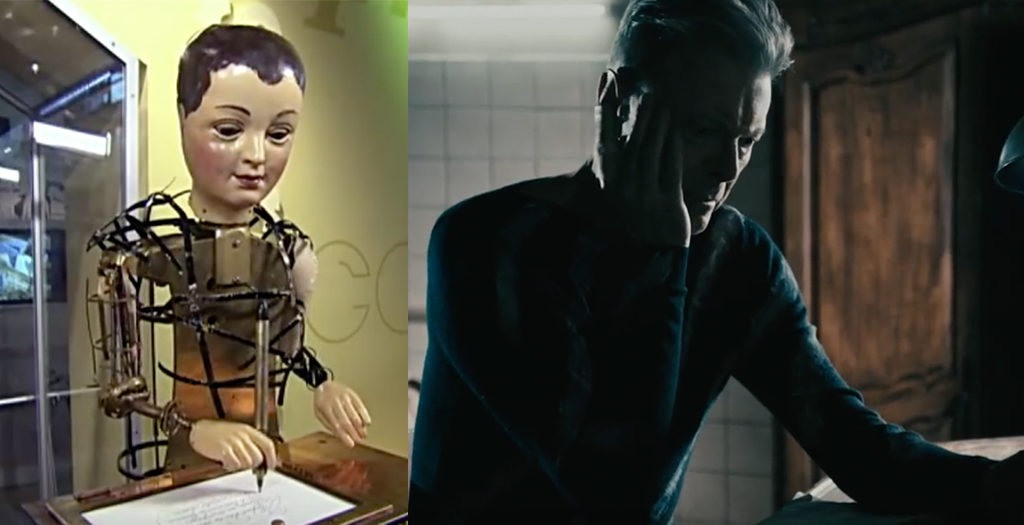
“It’s difficult for someone of my generation to break free of the intellectual automatism of the dialectical happy ending”, writes Bifo Berardi about irreversability. He compares this “taboo” concept to the “silent” apocalypses of our endless growth mentality, like Fukushima, corporate disaster unaccountability, socialized scarcity adjustments, and our silence on fellow human suffering. His book, The Uprising: On Poetry and Finance, speculates a “process of subjectivization” for the return of solidarity to a “social body”. This is the social body being culturally reprogrammed away under our collectively isolated movements of relentless market-driven consumption and precarity (individualist and systemic, like the fascist choreography of Kracauer’s Mass Ornament, or the Las Vegas showgirl spectacle). We might consider these grinding automaton gears of consumption and precarity the logics of late-terminal capitalism for clarity, it’s refusal a glitch in our clockwork performance. What is one to do for a postmodern exit other than to shudder, to write off the page? Ultimately, Berardi’s book leaves us more with a hope for our relational redemption from neoliberal culture through “sensibility” than it does with answers.
Blade Runner 2049 may not have been the sequel people wanted, but its confrontations with its own expectations provided a little of the things we need: a vision of the finite and anthropocene, a postmodern exit to the endless technologized avatars of getting what we think we want, our profound silence of the awful price. The film’s self-aware, nostalgic ruin leaves us with a little less of the typical sequel’s fourth wall, and an identification with its lonely bodies, caught in action between clockwork cultural predictability and its refusal. These bodies may or may not have the capacity for real love, but they are vulnerable at least to a larger sense of duty that Humanism, in all its universalizing failures, really needs. In this hybrid space of ontological awareness of the facets of knowing, experience and process, Blade Runner 2049’s success was inbetween all the things it could never definitively be. We too might realize that ‘doomed to fail’ may only be our insistence on choosing from a predetermined relational binary.
A distant song floats into the scene.
…“Though nothing, nothing will keep us together…”
When I saw Blade Runner 2049, in was at one of the remaining four hundred or so drive-in movie theaters left in the United States. I went back in memory to my kindling college interest in what I study and consider Avantpop, surveying the changes, considering its meaning and meaningless in my social development as a scholar: working class, woman, white, heterosexual; accepted and refused and abused entrances. The sequel came less than thirty years later in the revolution of a world for me, but I travelled farther to get there, out to a dark semi-rural drive-in beyond the city, and a memory of popping in a VHS tape almost 20 years ago simultaneously. I time-traveled mass media ontologies. I posted an instagram picture. It was semi-romantic nostalgia for me. But I still see that there is only now to change what we’re doing. And it is terrifying.
It’s quite an ending, to just die in silence, isn’t it?
But the fourth wall was always part of this, you know.
Featured Image: Ubermorgen, “Vote-Auction”, 2000. Installation view from the exhibition “Whistleblower & Vigilantes”
It has been a long time since an exhibition shocked and confused me. In fact, I cannot even remember when it last happened. Yet the exhibition Whistleblowers & Vigilanters has managed to do just that. Curators Inke Arns and Jens Kabisch of the Dortmund art institution Hartware Medienkunst Verein (HMKV) have put up a show in which complete nut cases are presented side by side with political activists, artists and whistleblowers a la Edward Snowden. This makes the exhibition ask for quite some flexibility from the audience. Visitors have to work hard in order to understand the connection made here between, for example, racist conspiracy theories expressed through YouTube videos and the ordeal of a whistleblower like Chelsea Manning.
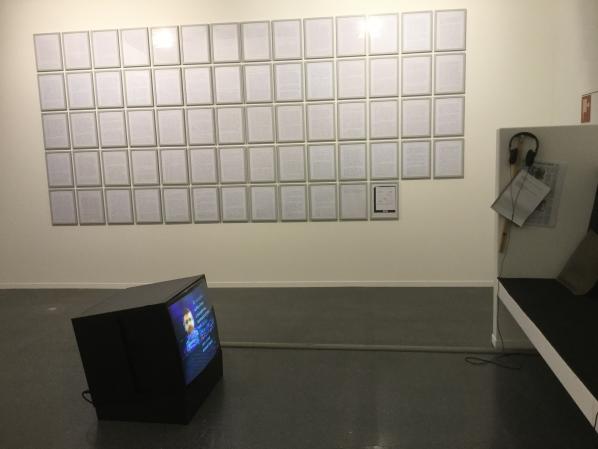
The very short introduction text to the exhibition guide is part of the puzzle we are presented with. The basic premises of the exhibition are explained in what I think is not the best possible manner, because it leaves out any mentioning or analysis of the huge political differences among the people and works presented. At the same time the use of words like higher law and self-legitimization easily creates a feeling of unease about each practitioner or type of activism in the show:
“The exhibition asks what links hacktivists, whistleblowers and (Internet) vigilantes. What is the legal understanding of these different actors? Do they share certain conceptions? Who speaks and acts for whom and in the capacity of which (higher) law? Among other issues the exhibition will examine the differing legal conceptions and strategies of self-legitimisation put forth by activists, whistleblowers, hackers, online activists and artists to justify their actions.”
By placing the revelations of Edward Snowden next to the complete print out of the manifesto of the Unabomber or (more harmless but still of a different level of impact) the battle over a hostile domain name takeover in Toywar the first impression is a levelling of the practices and people involved. To make some sort of distinction between the various represented rebellious or activist positions in the exhibition guide the whole is divided into sections. The sections however do not indicate socio-political position or relevance, but rather imply the ways people legitimize their actions (1).
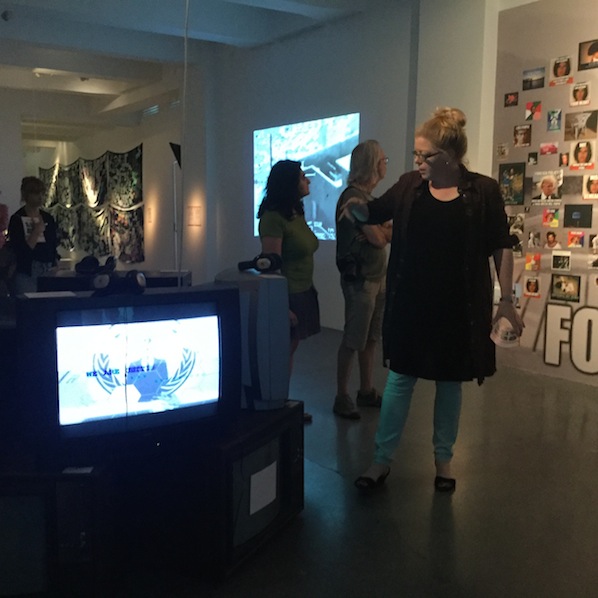
The spatial design and mapping of the exhibition seem to give some indication of political direction, but it is accidental. To the far right of the entry we find all installations labeled ‘Vigilantes’: a website collecting images of online fraudsters (419eater.com), two videos about Anders Breivik and Dominic Gagnon’s collection of mostly right-wing extremist YouTube videos. Slightly controversial is how the Vigilantes section puts together these quite obvious nut cases and criminals with Anonymous and what the curators call ‘Lulz’, the near troll-like jokesters who ridicule anything they don’t like with razor sharp memes. I am not sure whether these two products of the online forum 4chan deserve this simple pairing to YouTube hate preachers. A finer distinction between the various Internet underbelly representatives might have been better here. That this could have been done is shown by Lutz Dammbeck’s archive on the Unabomber’s placement in the Vigilante section, which has two labels. It is the sole representative of the Critique of Technology section as well. Another strange pairing happens in the Antinomism section, where an installation around a video with Julian Assange and a rightwing terrorist bomb disguised as soda machine are the only examples.
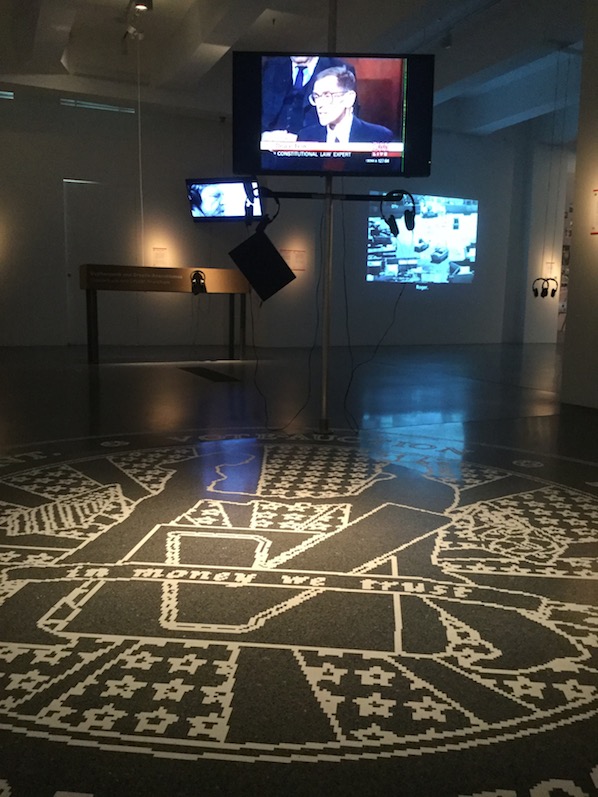
The middle ground of the exhibition shows a mix of artist activism and hacker culture. Mediengruppe Bitnik are here with a video of their Delivery for Mr. Assange. Black Transparency by Metahaven is represented through one utopian architecture model and printed wall cloths. The Peng! Collective’s Intelexit: Call-A-Spy has a telephone stand in the exhibition. The provocative sale of US votes in Vote-Auction by Ubermorgen is here as docu-installation. Etoy’s legendary Toywar is represented as well, with -in my opinion- too small a stand. Traces of many other art works and activist projects are presented in display cases, which give some more background or context to the theme. These were one of my favorite parts of the exhibition, next to the amazingly diligent and meticulous hand-drawn documentation of the Manning trial by Clark Stoeckley.
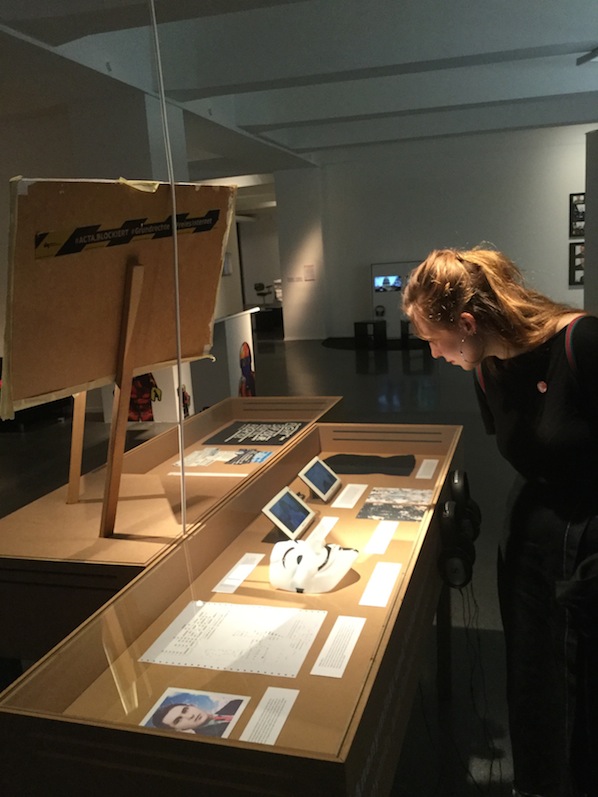
The display cases are dedicated to freedom of speech, tools of online resistance, the Netzpolitik case, anonymity and collective identities and cypherpunk and crypto-anarchism. They provide an important insight into the context within which the other practices in the exhibition exist.
Here we find Luther Blissett, the Italian born collective online identity, with a name borrowed from a former football player. The Blissett identity is related to pre-Internet art practices, in particular Neoism, and has been used for various art pranks and activist projects, particularly in Southern Europe.
Other art projects include the influential book Electronic Civil Disobedience by Critical Art Ensemble, the German hacker art collective Foebud’s battle for free speech and privacy (presented with one of Addie Wagenknecht’s anonymity glasses), and the Electronic Disturbance Theater’s Floodnet. The latter is a DDoS attack software that was used in actions for the Mexican freedom fighters the Zapatistas, by the Yes Men and for Etoy’s Toywar project.
There is also a print out of the Cypherpunk mailinglist. The cypherpunk crypto-anarchist community is responsible for some of the most influential elements of the free Internet. They produced the PGP encryption technology, cryptocurrency such as Bitcoin, TOR, the idea of WIKI and torrent platforms and marketplaces like the Silk Road. Julian Assange was one of its members.
Last but not least the presentation of the Netzpolitik.org case, which covers a German censorship scandal from last year, had to be part of this exhibition. Journalists from the online magazine Netzpolitik were arrested for treason after they had published about classified Internet surveillance plans of the German secret service. A copy of the accusation letter from the state prosecutor is oddly signed with ‘Mit freundlichen Grüßen’ (‘With kind regards’).
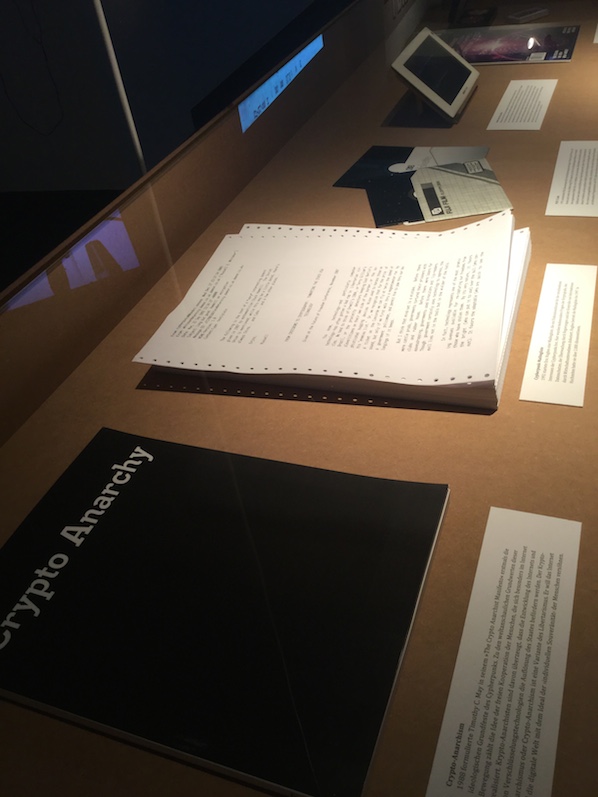
All in all the display cases made me happy to see some of the events and works that have been so hugely influential to the development of the Internet (and thus to the development of our current culture and politics) represented in a physical cultural space. They show a side of Internet culture that is heavily underrepresented in the general discourse around new media technologies in both mainstream media and art. During a private tour of Whistleblowers & Vigilantes for visitors of the simultaneously running Hito Steyerl exhibition Inke Arns explained how for her this exhibition is long overdue as well. According to Arns the threat to our freedom through abuse of new technologies should receive as much attention in art as the anthropocene. HMKV sees it as its responsibility to do something about it.
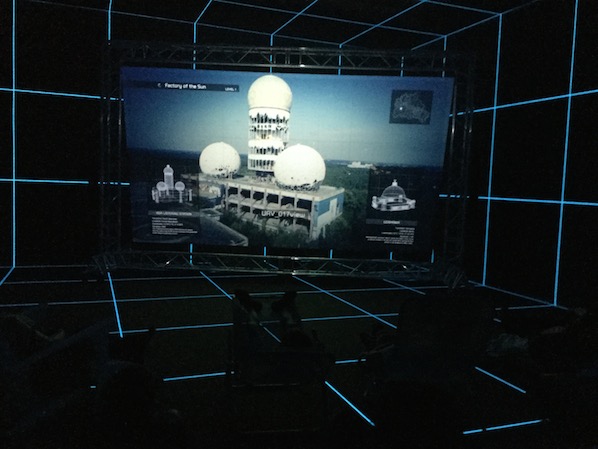
Whistleblowers & Vigilantes however does not make a straightforward statement. Its structure, both physically and content-wise, is too complex for that. This does not mean it is a bad exhibition. The bringing together of the ‘Lulz’, Anonymous, the Unabomber, net art, hacktivism, hackers and Manning, Snowden, Assange and even Breivik in one space definitely creates a lively exhibition, which cannot leave a visitor unaffected. This strange assembly then needs to be unraveled and this is where the curators take quite some risk. The addition of Hito Steyerl’s installation Factory of the Sun, an exhibition that runs simultaneously on a different floor, could help to bring the serious, crazy and light elements of the show together for that part of the audience that loses its way. In her smart playful manner Steyerl blends science fiction, humor and critique of the surveillance society in a faux holodeck cinema experience. The exhibition also includes a few live events that steer the whole into safe waters. Netzpolitik journalist Markus Beckedahl has given a presentation and so has Jens Kabisch. Kabisch wrote a text about whistleblowers that is available on the website, but this text is unfortunately only available in German. My advice to the non-German audience is to download the press kit in order to get more background information.
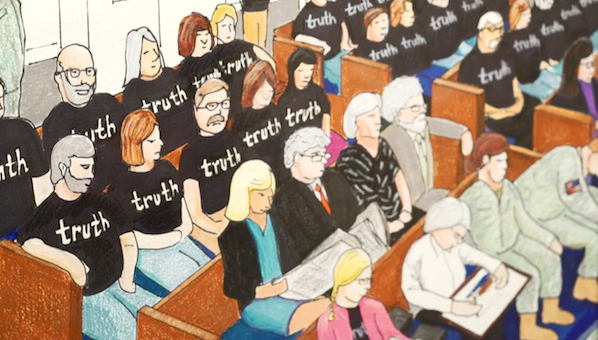
Whistleblowers & Vigilantes is a challenge to the audience. It asks for more reflection and time to take in than most exhibitions. After getting some more grip on it the complexity and scope of the exhibition, however, is impressive. It not only brings together many important, interesting and sometimes scary examples of contemporary forms of resistance and rebellion. What is also represented is the space of resistance and play that escapes attempts at systematic control, even in a full-on surveillance state. Once recovered from my initial shock this is what stayed with me the most. The wide-ranging documents, objects and installations reveal the system’s shadow spaces and vulnerabilities. Whistleblowers & Vigilanters differs from the flood of other art exhibitions themed around surveillance and control by reflecting on the legitimacy of online autonomous political action in general. Indirectly this means it also reflects upon the space of life that exists beyond all control. Rather than create another horror show around the future of privacy and freedom, with Whistleblower & Vigilanten we are presented with the persistence of fringe cultures and of free thinkers. For me this makes this an exhibition of hope.
Whistleblowers & Vigilantes. Figures of Digital Resistance
HMKV, Dortmund
9/4/16-14/8/16
https://www.hmkv.de/_en/programm/programmpunkte/2016/Ausstellungen/2016_VIGI_Vigilanten.php
https://www.hmkv.de/_pdf/Ausstellungsfuehrer/2016_VIGI_Kurzfuehrer_Web.pdf